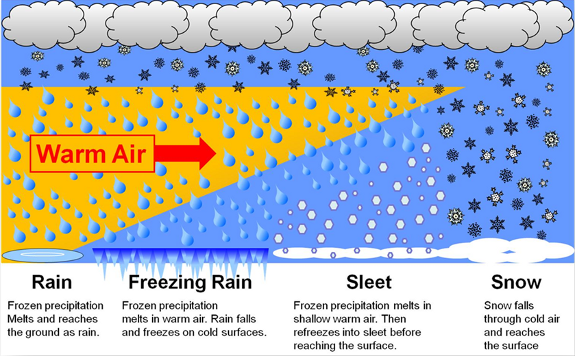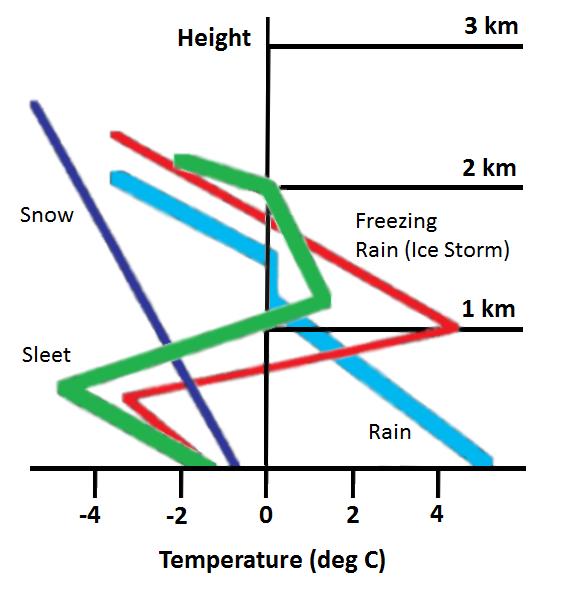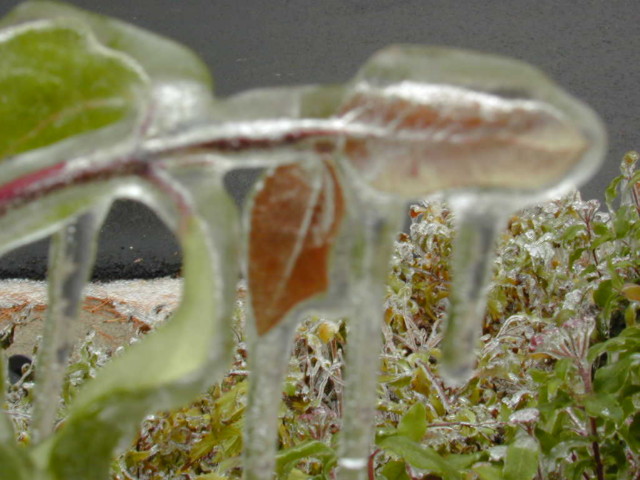Climate Change and Ice Storms
January 17, 2017
The GLB is experiencing an especially icy winter. Preliminary study indicates a warming climate could lead to a higher frequency of ice storms. Here’s how…
Ice storms (“glaze events”, or in some parts of the US a “silver thaw”) are historically normal. There is nothing particularly climate-changey about an ice storm in and of itself. The record ice accumulation in the US was set in the North American Ice Storm of 1961, with 8 inches of ice encasing parts of northern Idaho. However, as the globe continues to warm, the increased movement of warm air masses across the continent during winter could increase the frequency of icy weather.
Due to the obvious need to ruggedize in the face of potential increased ice glaze, and the need to effectively retort workplace climate change denials (e.g. “Look at all that ice. So much for global warming”), it might be a good idea to understand ice storms a little better than we already do.
[caption id="attachment_700" align="aligncenter" width="518"] Graphic: Wikimedia Commons[/caption]
The formation of ice begins with a layer of above-freezing air above a layer of sub-freezing temperatures closer to the surface. Frozen precipitation melts to rain while falling into the warm air layer, and then begins to refreeze in the cold layer below. If the precipitate refreezes while still in the air, it will land on the ground as sleet.
Alternatively, the liquid droplets can continue to fall without freezing, passing through the cold air just above the surface. This thin layer of air then cools the rain to a temperature below freezing (0 °C or 32 °F). However, the drops themselves do not freeze, a phenomenon called supercooling (or forming “supercooled drops“). When the supercooled drops strike ground or anything else below 0 °C freezing (power lines, tree branches for example), a layer of ice accumulates as the cold water drips off, forming a slowly thickening film of ice.
Given this information, simple logic shows how an increased presence of warm air masses can lead to more ice storms. But logic isn’t the only epistemology. What does the empiricism of science have to say about climate change and future ice storms?
Not much, yet. While consensus is clear that the overall climate is warming and will continue to warm, how that will effect the frequency of specific weather conditions such as ice storms remains unclear. It is generally accepted that there will be an increased frequency of storm events overall. Studies are being performed to determine whether or not that means more ice storms for the northeastern US and eastern Canada.
[caption id="attachment_701" align="aligncenter" width="563"]
Graphic: Wikimedia Commons[/caption]
The formation of ice begins with a layer of above-freezing air above a layer of sub-freezing temperatures closer to the surface. Frozen precipitation melts to rain while falling into the warm air layer, and then begins to refreeze in the cold layer below. If the precipitate refreezes while still in the air, it will land on the ground as sleet.
Alternatively, the liquid droplets can continue to fall without freezing, passing through the cold air just above the surface. This thin layer of air then cools the rain to a temperature below freezing (0 °C or 32 °F). However, the drops themselves do not freeze, a phenomenon called supercooling (or forming “supercooled drops“). When the supercooled drops strike ground or anything else below 0 °C freezing (power lines, tree branches for example), a layer of ice accumulates as the cold water drips off, forming a slowly thickening film of ice.
Given this information, simple logic shows how an increased presence of warm air masses can lead to more ice storms. But logic isn’t the only epistemology. What does the empiricism of science have to say about climate change and future ice storms?
Not much, yet. While consensus is clear that the overall climate is warming and will continue to warm, how that will effect the frequency of specific weather conditions such as ice storms remains unclear. It is generally accepted that there will be an increased frequency of storm events overall. Studies are being performed to determine whether or not that means more ice storms for the northeastern US and eastern Canada.
[caption id="attachment_701" align="aligncenter" width="563"] Graphic: Wikimedia Commons[/caption]
The conditions for an ice storm are, as we see above, complex. The unpredictable nature of vertical temperature profiles that lead to ice storms makes it difficult to predict increases in their frequency.
Researchers performed a simple “thought experiment” using vertical temperature profile data to explore how these might change given plausible future temperature regimes. Using an approximation for surface effects, they estimated that a temperature increase will result in an increased frequency of ice storm events throughout much of the winter across eastern Canada and in the U.S. west of the Appalachian Mountains as far south as Tennessee. Future changes in variability may enhance or moderate these changes.
Watch your step, but go forth. The patient epistemology of science must wait for the data to accumulate. Those of us building climate-resilient communities and fighting the rhetoric of climate denial can be fairly confident that as the globe continues to warm we will see more ice events like those we’ve experienced in the last couple weeks. Be careful walking and driving, and remember to go easy on the salt, it’s bad for the frogs.
Graphic: Wikimedia Commons[/caption]
The conditions for an ice storm are, as we see above, complex. The unpredictable nature of vertical temperature profiles that lead to ice storms makes it difficult to predict increases in their frequency.
Researchers performed a simple “thought experiment” using vertical temperature profile data to explore how these might change given plausible future temperature regimes. Using an approximation for surface effects, they estimated that a temperature increase will result in an increased frequency of ice storm events throughout much of the winter across eastern Canada and in the U.S. west of the Appalachian Mountains as far south as Tennessee. Future changes in variability may enhance or moderate these changes.
Watch your step, but go forth. The patient epistemology of science must wait for the data to accumulate. Those of us building climate-resilient communities and fighting the rhetoric of climate denial can be fairly confident that as the globe continues to warm we will see more ice events like those we’ve experienced in the last couple weeks. Be careful walking and driving, and remember to go easy on the salt, it’s bad for the frogs.
 Was this article helpful? Consider making a tax deductible donation to CACC. Our community outreach and education programs are funded by the support of donors like you. Thank you!
[paypal_donation_button]
Was this article helpful? Consider making a tax deductible donation to CACC. Our community outreach and education programs are funded by the support of donors like you. Thank you!
[paypal_donation_button]
 Graphic: Wikimedia Commons[/caption]
The formation of ice begins with a layer of above-freezing air above a layer of sub-freezing temperatures closer to the surface. Frozen precipitation melts to rain while falling into the warm air layer, and then begins to refreeze in the cold layer below. If the precipitate refreezes while still in the air, it will land on the ground as sleet.
Alternatively, the liquid droplets can continue to fall without freezing, passing through the cold air just above the surface. This thin layer of air then cools the rain to a temperature below freezing (0 °C or 32 °F). However, the drops themselves do not freeze, a phenomenon called supercooling (or forming “supercooled drops“). When the supercooled drops strike ground or anything else below 0 °C freezing (power lines, tree branches for example), a layer of ice accumulates as the cold water drips off, forming a slowly thickening film of ice.
Given this information, simple logic shows how an increased presence of warm air masses can lead to more ice storms. But logic isn’t the only epistemology. What does the empiricism of science have to say about climate change and future ice storms?
Not much, yet. While consensus is clear that the overall climate is warming and will continue to warm, how that will effect the frequency of specific weather conditions such as ice storms remains unclear. It is generally accepted that there will be an increased frequency of storm events overall. Studies are being performed to determine whether or not that means more ice storms for the northeastern US and eastern Canada.
[caption id="attachment_701" align="aligncenter" width="563"]
Graphic: Wikimedia Commons[/caption]
The formation of ice begins with a layer of above-freezing air above a layer of sub-freezing temperatures closer to the surface. Frozen precipitation melts to rain while falling into the warm air layer, and then begins to refreeze in the cold layer below. If the precipitate refreezes while still in the air, it will land on the ground as sleet.
Alternatively, the liquid droplets can continue to fall without freezing, passing through the cold air just above the surface. This thin layer of air then cools the rain to a temperature below freezing (0 °C or 32 °F). However, the drops themselves do not freeze, a phenomenon called supercooling (or forming “supercooled drops“). When the supercooled drops strike ground or anything else below 0 °C freezing (power lines, tree branches for example), a layer of ice accumulates as the cold water drips off, forming a slowly thickening film of ice.
Given this information, simple logic shows how an increased presence of warm air masses can lead to more ice storms. But logic isn’t the only epistemology. What does the empiricism of science have to say about climate change and future ice storms?
Not much, yet. While consensus is clear that the overall climate is warming and will continue to warm, how that will effect the frequency of specific weather conditions such as ice storms remains unclear. It is generally accepted that there will be an increased frequency of storm events overall. Studies are being performed to determine whether or not that means more ice storms for the northeastern US and eastern Canada.
[caption id="attachment_701" align="aligncenter" width="563"] Graphic: Wikimedia Commons[/caption]
The conditions for an ice storm are, as we see above, complex. The unpredictable nature of vertical temperature profiles that lead to ice storms makes it difficult to predict increases in their frequency.
Researchers performed a simple “thought experiment” using vertical temperature profile data to explore how these might change given plausible future temperature regimes. Using an approximation for surface effects, they estimated that a temperature increase will result in an increased frequency of ice storm events throughout much of the winter across eastern Canada and in the U.S. west of the Appalachian Mountains as far south as Tennessee. Future changes in variability may enhance or moderate these changes.
Watch your step, but go forth. The patient epistemology of science must wait for the data to accumulate. Those of us building climate-resilient communities and fighting the rhetoric of climate denial can be fairly confident that as the globe continues to warm we will see more ice events like those we’ve experienced in the last couple weeks. Be careful walking and driving, and remember to go easy on the salt, it’s bad for the frogs.
Graphic: Wikimedia Commons[/caption]
The conditions for an ice storm are, as we see above, complex. The unpredictable nature of vertical temperature profiles that lead to ice storms makes it difficult to predict increases in their frequency.
Researchers performed a simple “thought experiment” using vertical temperature profile data to explore how these might change given plausible future temperature regimes. Using an approximation for surface effects, they estimated that a temperature increase will result in an increased frequency of ice storm events throughout much of the winter across eastern Canada and in the U.S. west of the Appalachian Mountains as far south as Tennessee. Future changes in variability may enhance or moderate these changes.
Watch your step, but go forth. The patient epistemology of science must wait for the data to accumulate. Those of us building climate-resilient communities and fighting the rhetoric of climate denial can be fairly confident that as the globe continues to warm we will see more ice events like those we’ve experienced in the last couple weeks. Be careful walking and driving, and remember to go easy on the salt, it’s bad for the frogs.
 Was this article helpful? Consider making a tax deductible donation to CACC. Our community outreach and education programs are funded by the support of donors like you. Thank you!
[paypal_donation_button]
Was this article helpful? Consider making a tax deductible donation to CACC. Our community outreach and education programs are funded by the support of donors like you. Thank you!
[paypal_donation_button]